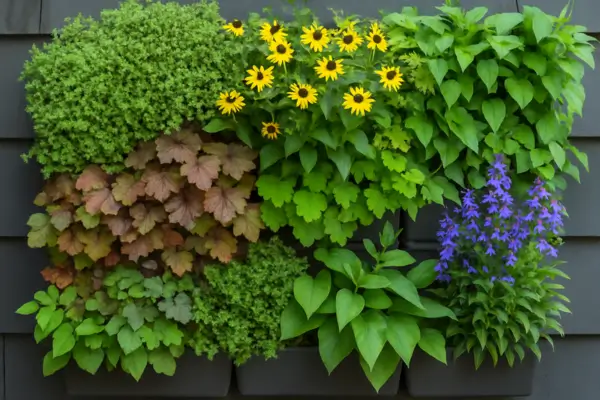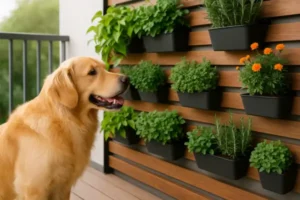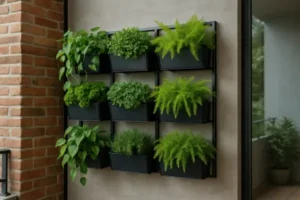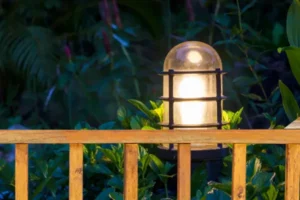Native Plants for Vertical Gardens offer a practical and beautiful way to bring greenery into tight city spaces. Whether you live in an apartment or a small home with limited outdoor space, native species are often the smartest choice for vertical gardening in urban settings.
These plants already know how to handle the rhythm of your local weather, making them more resilient and easier to care for. Instead of forcing exotic varieties to adapt, you’re giving room to plants that feel at home—and that can make your garden thrive with less effort.
Here, we’ll take a closer look at how native plants work in vertical systems, which species are best for different urban climates, and how you can build a green wall that truly fits into your routine.
Why Native Plants for Vertical Gardens Make Sense in Cities
Bringing native plants into vertical gardens isn’t just a design choice—it’s a practical strategy for anyone dealing with the ups and downs of urban gardening. In city settings, space is limited, sunlight shifts throughout the day, and wind patterns can change from one balcony to another.
Instead of relying on imported species that struggle to adapt, native plants offer a more natural fit for these conditions. They’re already familiar with the rhythms of your local climate, which means less maintenance, more resilience, and better overall results.
But to really understand the value they bring, we need to first get clear on what “native” truly means.
Understanding What “Native” Really Means
When we say native plants for vertical gardens, we’re not just referring to plants that grow in the wild near your home. We’re talking about species that have adapted over time to thrive in your local climate, soil conditions, and light cycles—without extra effort from you.
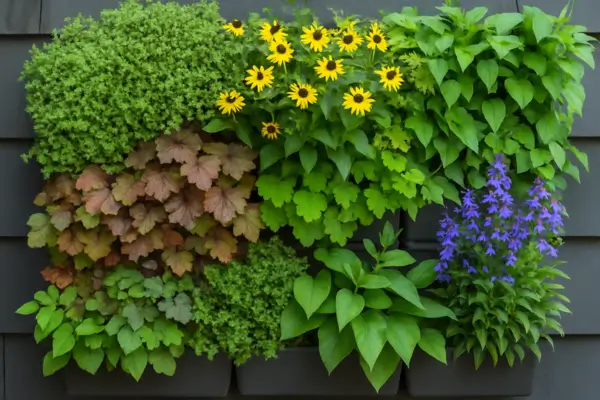
These plants usually require less watering, are more resistant to local pests, and don’t need constant adjustments to survive. That’s why they’re ideal for vertical gardens in urban spaces, where every inch and every minute counts.
How Urban Conditions Affect Plant Success
Unlike traditional gardens, vertical setups in cities face unique challenges. Sunlight might hit only one side of the wall. Wind currents can be unpredictable between buildings. And depending on your floor level, temperatures may vary quite a bit.
Here’s why native plants perform better in vertical gardens:
- They’re already used to your weather: That means fewer surprises with seasonal transitions.
- They grow well in local soil mixes: Even if you’re using potting media, native-friendly blends work better.
- They play nice with local pollinators: Your vertical garden can become a mini support system for bees and butterflies.
A Note on Maintenance
When your plant doesn’t fight the setting, you don’t have to fight the plant. Native species tend to grow in tune with the seasons, which helps you plan simple, consistent care routines.
If your goal is to have a beautiful, low-effort garden on your balcony or patio, starting with local species is one of the smartest moves you can make.
How Urban Conditions Affect Plant Success
City life can be tough on plants. Between concrete surfaces that reflect heat, wind tunnels created by tall buildings, and uneven light throughout the day, growing anything vertically in an urban space requires a bit of strategy.
This is exactly where native plants for vertical gardens stand out—they’re already prepared for these unpredictable conditions.
Most imported species need a controlled environment to stay healthy. Native plants, on the other hand, have grown accustomed to local stressors. They can handle dry spells, sudden rain, or rapid temperature shifts without falling apart.
In vertical gardens, where plants are more exposed and root systems are limited, this natural adaptability becomes a real asset.
Another key difference lies in light exposure. Many balconies or narrow spaces only receive a few hours of direct sun, if any. Native plants that evolved in partial shade or dappled light are far more likely to thrive in those microclimates. This means fewer burnt leaves, better color, and consistent growth throughout the year.
If you’re working with a wall that faces east or west, or a space that only gets filtered light, choosing native varieties increases your chances of success. These plants don’t just survive—they adjust, settle in, and flourish with what they’re given.
A Note on Maintenance
One of the biggest challenges with vertical gardens—especially in apartments or tight urban setups—is finding time for maintenance. That’s where native plants for vertical gardens can make your life much easier.
Because these plants are already adapted to your region, they tend to follow natural cycles. You won’t need to constantly guess when to prune, feed, or water. Their needs line up with local weather shifts, which means your routine can stay simple and steady.
For example, many native plants go dormant during the driest or coldest months, which gives you a built-in break. Others push out new growth just as seasonal rains begin. Instead of fighting to keep something alive year-round, you’re working with the plant’s instincts.
Here’s what a typical low-maintenance routine looks like when using native plants in vertical gardens:
- Watering: Less frequent, especially once the plant is established. Native species often tolerate short dry spells.
- Pruning: Mostly seasonal, with minor clean-ups as needed. Many species self-regulate their growth.
- Fertilizing: Rarely needed. If required, use a mild organic mix once or twice a year.
- Monitoring pests: Easier to manage, since native plants are less attractive to invasive pests and more resilient overall.
Because you’re not constantly adjusting, fertilizing, or repotting, the entire experience becomes more relaxed. And when your garden is on a balcony or compact patio, simplicity is everything.
Choosing the Right Native Plants for Your Vertical Garden
Finding the right native plants for vertical gardens isn’t just about grabbing a list of local species. It’s about understanding your space, your routine, and how your garden setup actually works. Once you align those factors, your plant choices become a lot more intuitive—and far more rewarding.
Let’s take a step-by-step look at how to make smart decisions when choosing native plants that will thrive on your wall, not just survive.
Think Local First
The best native plant for your vertical garden is likely one that’s already growing happily not far from where you live. That doesn’t mean it looks wild or out of place. In fact, many native species are compact, colorful, and work beautifully in decorative gardens.
Start with what’s familiar to your region:
- Visit local nurseries and ask about native species suited for containers.
- Check with nearby botanical gardens—they often publish curated lists of easy-to-grow natives.
- Browse community gardening forums or city green programs; they sometimes highlight plants that do well in limited spaces like balconies or patios.
Also, look for dwarf or compact cultivars of native plants. These versions are ideal for vertical systems where space is tight, but you still want texture, color, or seasonal blooms.
Match the Plant to the Structure
Not all vertical gardens are built the same way, and that matters more than most people realize. Each system—felt pockets, stackable containers, modular walls—has its own demands. Some hold more moisture, some dry out quickly, some offer depth, others don’t.
Here’s a quick guide to help you pair native plants with common vertical garden formats:
- Felt pocket panels: Best for small-root natives like wild strawberry, creeping phlox, or columbine—plants that don’t mind shallow soil and can spill over edges naturally.
- Stacked planters or vertical crates: A good fit for upright growers like yarrow, purple coneflower, or goldenrod, which need a bit more root space but still adapt well to confined systems.
- Modular container walls: These offer the most flexibility and can support a mix of trailing and clumping plants, including coral bells, native sedges, and wild geraniums.
Think of it this way: you’re designing a living wall with pieces that actually fit the puzzle. When the structure complements the plant—and vice versa—you’ll spend less time fixing problems and more time enjoying your green space.
Microclimates Matter: Choosing Natives by Sunlight and Wind
Even within a single balcony, conditions can shift drastically. One corner might get full morning sun, while another stays in shade all day. The top of your wall might be exposed to wind, while the lower half stays more humid.
That’s why understanding microclimates is a huge part of making native plants for vertical gardens work long-term.
Observe Before You Plant
Take a few days to really watch your space. Notice which parts of your vertical wall get sun in the morning, afternoon, or not at all. Pay attention to airflow—some balconies are wind tunnels, while others stay still and humid.
Once you understand how your wall behaves, you can start grouping native plants based on what they naturally like:
- Full sun sections: Choose tough, sun-loving natives like coreopsis, native milkweed, or bee balm.
- Shady spots: Go for woodland natives like foamflower, wild ginger, or solomon’s seal.
- Windy edges: Look for flexible-stemmed plants such as switchgrass, little bluestem, or penstemon, which hold up well without snapping.
- Sheltered areas: Softer-leaved natives like columbine or lobelia can settle here comfortably.
Balance is Key
A vertical garden doesn’t have to be filled with just one kind of plant. In fact, a mix often works better. You might place sun-lovers at the top, shade-tolerant types near the bottom, and let trailing plants soften the edges in between.
This layered approach doesn’t just look good—it reflects the way plants would grow naturally in the wild, adjusted to light, air, and moisture patterns.
When your layout honors the microclimates of your own wall, your native plants settle in faster and stay stronger with less correction from you.
Using Native Plants for Seasonal Themes and Visual Flow
Most vertical garden guides focus on survival and structure—but once your system is set up, the next step is making it feel alive year-round. One often overlooked benefit of native plants for vertical gardens is how they can be used to create seasonal rhythm and visual storytelling across your wall.
Designing with Local Seasons in Mind
Because native plants are tuned into the timing of your local seasons, you can create a living tapestry that changes throughout the year—without swapping plants every few months. Some species bloom early, others later. Some go dormant gracefully, adding texture and color even as they rest.
By mixing native species with staggered bloom cycles, you can plan for a natural flow:
- Spring starters: Plants like wild blue phlox and columbine pop early, bringing soft color and a sense of renewal.
- Summer standouts: Coreopsis, coneflower, and bee balm hit their stride with bright tones and upright structure.
- Fall finishers: Aromatic aster, goldenrod, and bluestar offer late blooms and golden hues that echo autumn light.
- Winter texture: Native grasses like switchgrass or the dried seed heads of echinacea add structure and subtle movement during colder months.
This natural rotation makes your garden feel like it’s telling a story—a rhythm of color, form, and rest that doesn’t require constant rearranging.
Creating Vertical Flow, Not Just Decoration
Another design trick that few guides mention is vertical visual flow. Most people plant without thinking about how the eye moves across the garden. But native plants offer different heights, leaf shapes, and textures that you can layer intentionally.
Here’s a simple approach:
- Use bushy natives like coral bells or geranium in the middle zones to anchor the wall.
- Add upright growers toward the top for vertical energy.
- Let trailing species like wild strawberry or creeping phlox soften the edges and give a sense of gravity.
- Insert contrasting textures—fine leaves against broad ones, or silvery foliage next to green—to break up visual monotony.
This attention to form and rhythm creates a vertical garden that feels designed, not just planted. And when your plants are native, it all happens in tune with your local world.
Common Mistakes When Choosing Native Plants for Vertical Gardens
Creating a thriving vertical garden with native plants is easier when you avoid a few common traps. These mistakes don’t come from lack of effort—they usually come from assuming that “native” means “easy no matter what.” But even local species need the right setup to perform well in vertical systems.
Assuming All Natives Are Low Maintenance
While native plants generally need less attention, not all of them are suited for compact vertical gardens. Some natives grow deep roots, spread aggressively, or need more soil than your structure can provide. That’s why it’s important to choose species not just by origin, but by growth habit and root depth.
If a plant evolved to sprawl across open ground or form a large taproot, it probably won’t be happy in a shallow container—even if it’s technically local.
Ignoring Sun and Water Differences Across the Wall
Another mistake is treating the entire vertical wall as one uniform space. As we saw earlier, conditions vary by height, direction, and even surface material. If you plant a full-sun native in the shady corner of your wall, it’ll still struggle.
Instead, take time to match plant preferences to specific micro-zones. This not only helps plants thrive, but also reduces the amount of maintenance you’ll need later.
Overwatering or Overcrowding
Native plants are often used to well-draining soil and periodic dry spells. Vertical gardens, however, can hold more moisture than expected—especially in the lower pockets. Overwatering is a quick way to cause root rot or fungal issues, even in tough native species.
Another common mistake is planting too densely. Native plants need room to breathe, and in a tight vertical layout, too many roots competing in the same space can lead to poor growth and more maintenance.
Quick Tip Checklist to Avoid Common Issues
- Check if the native species is shallow-rooted before planting.
- Group plants by sun needs—not just appearance.
- Use well-draining potting mix suitable for native plants.
- Avoid planting more than one species per pocket unless the roots are very shallow.
- Start with fewer plants, and let them fill in naturally.
Learning from these missteps is part of the process—but with a little planning, you can avoid most of them from the start.
Watering Made Easy: Support Your Garden, Don’t Stress Over It
One of the best parts of using native plants for vertical gardens is how naturally they settle in. Still, a little support can make your routine even easier.
Instead of watering by hand every day, you can install a simple drip system. It’s quiet, discreet, and takes care of your plants while you enjoy your mornings.
Start by observing your wall. Notice which sections stay sunnier or cooler throughout the day. That helps you decide where each plant goes.
A natural layout often works like this:
- Top section: Drier zones, great for sun-loving plants like wild thyme or black-eyed Susan
- Middle section: Balanced space, ideal for coral bells or native geraniums
- Lower section: Slightly more humid, perfect for wild ginger or lobelia
Connect a small drip line along the top and let gravity do the rest. Add a timer, set it for early mornings, and you’re done. With this setup, you’re not controlling nature—you’re simply working with it. The garden stays vibrant, and your time stays yours.
Conclusao
Choosing native plants for vertical gardens isn’t just about being practical—it’s about working with what already belongs. These species are tuned to your local rhythms, and that makes everything simpler, from watering to growth.
When you build a vertical garden around what thrives naturally in your area, it becomes more than decoration. It turns into a space that reflects your environment, your habits, and your sense of balance.
The beauty of native plants is that they ask for less and offer more. With a little planning, the right setup, and attention to your space, your wall can grow into something that feels alive, not just planted. And the best part? It fits your life, not the other way around.

